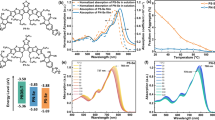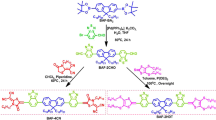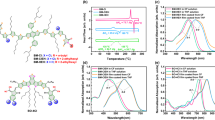Abstract
Organic photovoltaic devices that can be fabricated by simple processing techniques are under intense investigation in academic and industrial laboratories because of their potential to enable mass production of flexible and cost-effective devices1,2. Most of the attention has been focused on solution-processed polymer bulk-heterojunction (BHJ) solar cells3,4,5,6,7. A combination of polymer design, morphology control, structural insight and device engineering has led to power conversion efficiencies (PCEs) reaching the 6–8% range for conjugated polymer/fullerene blends8,9. Solution-processed small-molecule BHJ (SM BHJ) solar cells have received less attention, and their efficiencies have remained below those of their polymeric counterparts10. Here, we report efficient solution-processed SM BHJ solar cells based on a new molecular donor, DTS(PTTh2)2. A record PCE of 6.7% under AM 1.5 G irradiation (100 mW cm−2) is achieved for small-molecule BHJ devices from DTS(PTTh2)2:PC70BM (donor to acceptor ratio of 7:3). This high efficiency was obtained by using remarkably small percentages of solvent additive (0.25% v/v of 1,8-diiodooctane, DIO) during the film-forming process, which leads to reduced domain sizes in the BHJ layer. These results provide important progress for solution-processed organic photovoltaics and demonstrate that solar cells fabricated from small donor molecules can compete with their polymeric counterparts.
This is a preview of subscription content, access via your institution
Access options
Subscribe to this journal
Receive 12 print issues and online access
$259.00 per year
only $21.58 per issue
Buy this article
- Purchase on Springer Link
- Instant access to full article PDF
Prices may be subject to local taxes which are calculated during checkout



Similar content being viewed by others
References
Kippelen, B. & Brédas, J. L. Organic photovoltaics. Energy Environ. Sci. 2, 251–261 (2009).
Krebs, F. C. Fabrication and processing of polymer solar cells: A review of printing and coating techniques. Sol. Energy Mater. Sol. Cells 93, 394–412 (2009).
Boudreault, P-L. T., Najari, A. & Leclerc, M. Processable low-bandgap polymers for photovoltaic applications. Chem. Mater. 23, 456–469 (2011).
Brabec, C. J. et al. Polymer–fullerene bulk-heterojunction solar cells. Adv. Mater. 22, 3839–3856 (2010).
Scharber, M. C. et al. Design rules for donors in bulk-heterojunction solar cells—towards 10% energy-conversion efficiency. Adv. Mater. 18, 789–794 (2006).
Cheng, Y. J., Yang, S. H. & Hsu, C. S. Synthesis of conjugated polymers for organic solar cell applications. Chem. Rev. 109, 5868–5923 (2009).
Walker, B., Kim, C. & Nguyen, T-Q. Small molecule solution-processed bulk heterojunction solar cells. Chem. Mater. 23, 470–482 (2011).
Park, S. H. et al. Bulk heterojunction solar cells with internal quantum efficiency approaching 100%. Nature Photon. 3, 297–302 (2009).
Liang, Y. et al. For the bright future—bulk heterojunction polymer solar cells with power conversion efficiency of 7.4%. Adv. Mater. 22, E135–E138 (2010).
Roncali, J. Molecular bulk heterojunctions: An emerging approach to organic solar cells. Acc. Chem. Res. 42, 1719–1730 (2009).
Thompson, B. C. & Fréchet, J. M. J. Polymer–fullerene composite solar cells. Angew. Chem. Int. Ed. 47, 58–77 (2008).
Roncali, J. Synthetic principles for bandgap control in linear π-conjugated systems. Chem. Rev. 97, 173–205 (1997).
Meier, H. Conjugated oligomers with terminal donor–acceptor substitution. Angew. Chem. Int. Ed. 44, 2482–2506 (2005).
Ko, H. M. et al. Molecular engineering of push-pull chromophore for efficient bulk-heterojunction morphology in solution processed small molecule organic photovoltaics. J. Mater. Chem. 21, 7248–7253 (2011).
Mayerhoffer, U. et al. Outstanding short-circuit currents in BHJ solar cells based on NIR-absorbing acceptor-substituted squaraines. Angew. Chem. Int. Ed. 48, 8776–8779 (2009).
Bagnis, D. et al. Marked alkyl- vs alkenyl-substitutent effects on squaraine dye solid-state structure, carrier mobility, and bulk-heterojunction solar cell efficiency. J. Am. Chem. Soc. 132, 4074–4075 (2010).
Shang, H. et al. A solution-processable star-shaped molecule for high-performance organic solar cells. Adv. Mater. 23, 1554–1557 (2011).
Walker, B. et al. Nanoscale phase separation and high photovoltaic efficiency in solution-processed, small-molecule bulk heterojunction solar cells. Adv. Funct. Mater. 19, 3063–3069 (2009).
Loser, S. et al. A naphthodithiophene-diketopyrrolopyrrole donor molecule for efficient solution-processed solar cells. J. Am. Chem. Soc. 133, 8142–8145 (2011).
Würthner, F. & Meerholz, K. Systems chemistry approach in organic photovoltaics. Chem. Eur. J. 16, 9366–9373 (2010).
Rousseau, T. et al. BODIPY derivatives as donor materials for bulk heterojunction solar cells. Chem. Commun. 1673–1675 (2009).
Welch, G. C. et al. A modular molecular framework for utility in small-molecule solution-processed organic photovoltaic devices. J. Mater. Chem. 21, 12700–12709 (2011).
Wei, G., Wang, S., Sun, K., Thompson, M. E. & Forrest, S. R. Solvent-annealed crystalline squaraine: PC70BM (1:6) solar cells. Adv. Energy Mater. 1, 184–187 (2011).
Fitzner, R. et al. Dicyanovinyl-substituted oligothiophenes: Structure-property relationships and application in vacuum-processed small-molecule organic solar cells. Adv. Funct. Mater. 21, 897–910 (2011).
Blouin, N. et al. Toward a rational design of poly(2,7-carbazole) derivatives for solar cells. J. Am. Chem. Soc. 130, 732–742 (2008).
Hou, J. H. et al. Synthesis, characterization, and photovoltaic properties of a low band gap polymer based on silole-containing polythiophenes and 2,1,3-benzothiadiazole. J. Am. Chem. Soc. 130, 16144–16145 (2008).
Wu, W., Liu, Y. & Zhu, D. π-Conjugated molecules with fused rings for organic field-effect transistors: Design, synthesis and applications. Chem. Soc. Rev. 39, 1489–1502 (2010).
Sun, Y. et al. Efficient, air-stable bulk heterojunction polymer solar cells using MoOx as the anode interfacial layer. Adv. Mater. 23, 2226–2230 (2011).
Peet, J. et al. Efficiency enhancement in low-bandgap polymer solar cells by processing with alkane dithiols. Nature Mater. 6, 497–500 (2007).
Lovinger, A. J., Katz, H. E. & Dodabalapur, A. Direct imaging of conducting and insulating submolecularly wide pathways in an organic semiconductor. Chem. Mater. 10, 3275–3277 (1998).
Drummy, L. F. et al. Molecular-scale and nanoscale morphology of P3HT:PCBM bulk heterojunctions: Energy-filtered TEM and low-dose HREM. Chem. Mater. 23, 907–912 (2011).
Acknowledgements
The design, synthesis and characterization of DTS(PTTh2)2 was supported by the Center for Energy Efficient Materials, an Energy Frontier Research Center funded by the Office of Basic Energy Sciences of the US Department of Energy (DE-DC0001009). The solar-cell fabrication and optimization was supported by the Air Force Office of Scientific Research (FA9550-11-1-0063). The TEM studies were supported by the National Science Foundation (DMR-0856060). The authors thank M. Chabinyc (UCSB) for useful discussions on the TEM analysis, C. Hoven (UCSB) for contributions to the development of the device fabrication methodology and B.B.Y. Hsu (UCSB) for the thickness measurement. W.L.L. thanks the Agency for Science Technology and Research (A*Star) of Singapore for a postdoctoral fellowship.
Author information
Authors and Affiliations
Contributions
G.C.B. and A.J.H. proposed the research. G.C.W. designed, synthesized and characterized the materials. Y.S. and W.L.L. carried out the fabrication and measurement of electronic devices. C.J.T. carried out the TEM characterization and image analysis. All authors contributed to the writing of the manuscript.
Corresponding authors
Supplementary information
Supplementary Information
Supplementary Information (PDF 2569 kb)
Rights and permissions
About this article
Cite this article
Sun, Y., Welch, G., Leong, W. et al. Solution-processed small-molecule solar cells with 6.7% efficiency. Nature Mater 11, 44–48 (2012). https://doi.org/10.1038/nmat3160
Received:
Accepted:
Published:
Issue Date:
DOI: https://doi.org/10.1038/nmat3160
This article is cited by
-
Multi-scale mechanical properties of bulk-heterojunction films in polymer solar cells
npj Flexible Electronics (2023)
-
Efficient screening framework for organic solar cells with deep learning and ensemble learning
npj Computational Materials (2023)
-
Socio-economic impacts of solar energy technologies for sustainable green energy: a review
Environment, Development and Sustainability (2023)
-
Impact of ester-anchored alkyl side chains on the interfacial arrangement and charge transfer in organic solar cells
Theoretical Chemistry Accounts (2023)
-
Large-area perovskite solar cells employing spiro-Naph hole transport material
Nature Photonics (2022)



